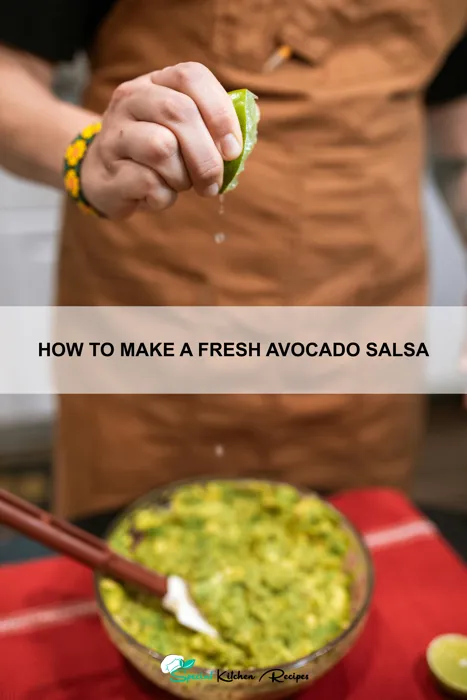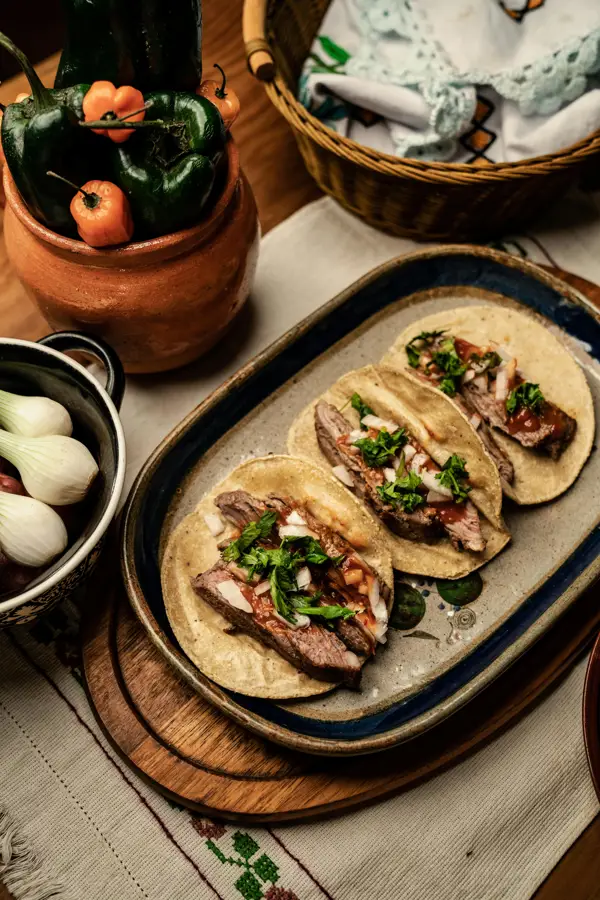Prepare to tantalize your taste buds with a vibrant and refreshing culinary journey into the heart of Mexican cuisine: fresh avocado salsa. This isn’t just a dip; it’s a celebration of flavor, a testament to the ingenuity of blending simple ingredients into a complex and satisfying experience. While pinpointing the exact origin is difficult, the foundation of avocado salsa is deeply rooted in the rich culinary history of Mexico, where avocados have been a staple for thousands of years. Archaeological evidence suggests avocado cultivation dates back to at least 5000 BC, showcasing its enduring importance in Mesoamerican diets. Ancient civilizations revered the avocado, not only for its nutritional value but also for its symbolic significance.
The evolution of avocado salsa reflects the dynamic nature of Mexican gastronomy. Over centuries, various indigenous cultures developed their own variations, incorporating local ingredients and techniques. While the exact recipe varied regionally, the core elements – ripe avocados, tomatoes, onions, and chili peppers – remained constant, creating a base that has been adapted and reinterpreted countless times. Today, avocado consumption globally has exploded. The United States is the largest importer of avocados, with annual consumption figures reaching staggering amounts. This overwhelming popularity speaks to the avocado’s versatility and its ability to transcend cultural boundaries, becoming a beloved ingredient across continents.
The cultural significance of avocado salsa extends beyond its deliciousness. It’s a staple at countless celebrations, from casual gatherings to festive occasions. It represents a connection to tradition, a shared experience enjoyed across generations. The vibrant green hue of the salsa itself is often associated with the colors of nature and fertility in Mexican culture. More than just a condiment, avocado salsa is frequently used as a component in various dishes, adding a creamy richness and a layer of complexity to tacos, tostadas, and other traditional Mexican fare. This recipe will guide you through creating a simple yet authentic version of this beloved dish, allowing you to savor the taste of history and culture with every bite.
Ingredients and Measurements
Creating a vibrant and flavorful avocado salsa hinges on using fresh, high-quality ingredients. The precise measurements can be adjusted to your taste, but these quantities provide a well-balanced starting point for approximately 2 cups of salsa. Remember to always taste and adjust seasoning as you go, adding more lime juice for acidity, salt for savoriness, or cilantro for freshness, as needed.
Avocados: 2 large, ripe avocados (approximately 1 pound). Choosing ripe avocados is crucial. Gently press the avocado; it should yield to gentle pressure but not be mushy. Overripe avocados will result in a mushy salsa. If your avocados are underripe, allow them to ripen at room temperature for a day or two before using.
Red Onion: ½ medium red onion, finely diced. Red onion provides a sharp bite that complements the creamy avocado. Avoid using white or yellow onion, as their stronger flavor can overpower the delicate avocado taste. Finely dicing the onion ensures it blends well without being overly noticeable.
Roma Tomatoes: 1 cup, finely diced. Roma tomatoes, with their lower water content, are ideal for salsa. Avoid using juicy tomatoes like heirloom varieties, as they can make the salsa watery. Dicing them finely helps them integrate seamlessly into the mixture.
Cilantro: ½ cup, finely chopped. Fresh cilantro adds a bright, herbaceous flavor. If you dislike cilantro, you can substitute it with a similar amount of finely chopped parsley, though the flavor profile will be subtly different. Ensure the cilantro is fresh and vibrant green for the best flavor.
Jalapeño Pepper: 1-2 jalapeños, seeded and minced (adjust to your spice preference). Remove the seeds and membranes for a milder salsa; leaving them in will significantly increase the heat. Mincing the jalapeño ensures even heat distribution throughout the salsa.
Lime Juice: 2 tablespoons, freshly squeezed. Fresh lime juice is essential for balancing the richness of the avocado and adding a bright, citrusy note. Bottled lime juice lacks the vibrant flavor of fresh juice. Taste and adjust as needed; you may want more or less depending on the ripeness of your avocados.
Salt: 1 teaspoon, or to taste. Kosher salt is preferred for its clean flavor. Start with 1 teaspoon and adjust to your preference. Taste the salsa before serving and add more salt if needed.
Equipment List
Making fresh avocado salsa requires minimal equipment, but the right tools will ensure a smoother, more efficient process and a superior final product. This list details the essential items, along with recommendations for optimal results.
Cutting Board: A large, sturdy cutting board is crucial. Choose one that’s easy to clean and preferably made of a material that won’t dull your knives, such as plastic or wood. Avoid glass cutting boards, as they are prone to chipping and can damage your knives. A size of at least 12 x 16 is recommended to comfortably accommodate all the ingredients.
Chef’s Knife: A sharp chef’s knife (approximately 8-inch blade) is the workhorse of this recipe. A sharp knife ensures clean cuts and prevents bruising the avocados, which can lead to browning. Invest in a high-quality chef’s knife and keep it properly sharpened for optimal performance. A smaller paring knife might also be helpful for more delicate tasks like removing the seeds from the jalapeño peppers.
Measuring Cups and Spoons: Accurate measurements are key to achieving the perfect balance of flavors. Having both liquid and dry measuring cups, as well as a set of measuring spoons, will allow you to precisely measure the ingredients. Using accurate measurements is crucial for consistent results. A 1-cup liquid measuring cup, a ½-cup dry measuring cup, and a set of measuring spoons (¼ teaspoon to 1 tablespoon) are sufficient.
Mixing Bowl: A medium-sized mixing bowl (approximately 3-quart capacity) is needed to combine all the ingredients after they have been chopped. A bowl with a non-reactive surface, such as glass or stainless steel, is recommended to prevent any unwanted reactions with the ingredients. Avoid using reactive bowls made of copper or aluminum, as they can affect the flavor and color of the salsa.
Fork or Masher (Optional): While not strictly necessary, a fork or a small potato masher can be used to gently mash the avocados if you prefer a slightly chunkier salsa. This is a matter of personal preference; some prefer a smoother salsa, while others prefer a more textured one. Avoid over-mashing the avocados, as this can make the salsa too watery.
Serving Bowl: Finally, you’ll need a serving bowl to present your delicious homemade avocado salsa. Choose a bowl that complements your table setting and allows the vibrant colors of the salsa to shine. A small to medium-sized bowl (approximately 4-6 cups) is ideal for serving.
Preparation of Ingredients
Before you begin assembling your vibrant avocado salsa, meticulous preparation of the ingredients is key to achieving the perfect texture and flavor balance. We’ll be using ripe avocados, red onion, juicy tomatoes, and a few other elements to create a delicious dip.
Let’s start with the avocados. For this recipe, we’ll need two ripe but firm avocados. To check for ripeness, gently squeeze the avocado; it should yield slightly to pressure but not feel mushy. Once you’ve selected your avocados, wash them thoroughly under cold running water. Using a sharp knife, carefully cut the avocado in half lengthwise, following the natural seam. Twist the halves apart, and remove the pit with a spoon or knife. Avoid cutting into the pit itself, as this can cause discoloration. Now, using the same knife, carefully dice the avocado flesh into approximately ½-inch cubes. Work quickly to minimize browning.
Next, prepare the red onion. We’ll use ¼ cup of finely diced red onion. This adds a delightful sharpness to the salsa, but too much can overpower the other flavors. Begin by peeling the onion. Cut the onion in half from pole to pole, then slice it thinly. Finally, finely dice the onion slices into small pieces. Remember to avoid crying while chopping onions by chilling the onion for 30 minutes beforehand or by using a sharp knife.
For the tomatoes, we’ll use one medium-sized ripe tomato, diced into ½-inch pieces. Choose tomatoes that are firm and red for the best flavor and texture. Wash the tomato thoroughly and cut it in half. Remove the stem and core. Use a knife to dice the tomato into roughly ½-inch pieces. Remove any seeds if you prefer a less watery salsa.
Finally, remember to prepare any additional ingredients you are adding to your recipe. This might include cilantro, jalapeño, lime juice, or other spices. Always wash and prepare all ingredients thoroughly before use to ensure food safety and optimal flavor.
Once all your ingredients are prepped, you can proceed to the next step of creating your delicious avocado salsa. Proper preparation ensures a smooth and enjoyable cooking process.
Mixing the Salsa
Once all your ingredients are prepped, the fun part begins – combining them into a vibrant and flavorful salsa! The key to a great salsa is a gentle hand and a good balance of flavors. We’ll be making approximately 2 cups of salsa, perfect for serving with tortilla chips or as a topping for your favorite dishes.
Begin by adding the diced avocados (1 large or 2 medium, approximately 2 cups diced) to a medium-sized bowl. Avoid over-mixing the avocados at this stage, as it can lead to browning and a less appealing texture. Gently toss them to distribute them evenly in the bowl.
Next, add the finely diced red onion (½ medium red onion, approximately ½ cup diced). Red onion adds a nice bite and beautiful color, but be mindful not to overdo it, as too much can overpower the other flavors. Follow this with the chopped tomatoes (2 cups, approximately 2 medium tomatoes, diced). Again, a gentle toss is all that’s needed.
Now, incorporate the vibrant cilantro (½ cup, firmly packed, finely chopped). Fresh cilantro is crucial for that authentic salsa taste. If you don’t have fresh cilantro, you can substitute with a teaspoon of dried cilantro, but the flavor will be less intense. Add the jalapeño pepper (1-2, depending on your spice preference, finely minced). Remember to remove the seeds and membranes for less heat.
Finally, we’ll add the lime juice (2 tablespoons, freshly squeezed). Freshly squeezed lime juice is essential for brightness and acidity; bottled lime juice won’t provide the same zing. Season generously with salt (1 teaspoon, or to taste) and freshly ground black pepper (¼ teaspoon, or to taste). Taste and adjust seasoning as needed. Some people prefer a spicier salsa, so feel free to add more jalapeño. Others might prefer a bit more lime juice for extra tang.
Now, using a large spoon or spatula, gently fold all the ingredients together. Avoid vigorous mixing, as this can bruise the avocados and release too much moisture. A few gentle folds are all you need to combine everything evenly. Taste again and adjust seasoning if needed. Your fresh avocado salsa is ready to be enjoyed!
Professional Tip: For a smoother salsa, you can lightly mash some of the avocados with a fork before adding the other ingredients. This is a matter of personal preference, however. Some prefer a chunky salsa while others prefer a smoother consistency.
Seasoning and Taste Adjustment
Seasoning your avocado salsa is crucial to achieving the perfect balance of flavors. The goal is to enhance the natural sweetness of the avocado while adding a vibrant kick of acidity and a hint of savory depth. Start with a conservative approach, adding ingredients gradually and tasting frequently to avoid over-seasoning.
Begin by adding 1/2 teaspoon of kosher salt. Kosher salt is preferred for its larger crystals, which dissolve more slowly and allow for better control. Taste the salsa and adjust accordingly; you might need slightly more or less depending on the saltiness of your avocados. Remember that salt enhances the other flavors, so don’t be afraid to use it judiciously.
Next, incorporate 1/4 cup of freshly squeezed lime juice. Lime juice provides the essential acidity that cuts through the richness of the avocado, preventing the salsa from becoming overly creamy. Again, taste and adjust. You may prefer more or less lime juice depending on your preference for tartness and the acidity of your limes. If the salsa seems too tart, add a pinch of sugar – 1/4 teaspoon of granulated sugar or a touch more, to balance it out.
Now, it’s time to add your heat. Start with a small amount of finely chopped jalapeño, about 1/4 of a small jalapeño, seeded and minced. If you prefer a milder salsa, use less or omit the seeds entirely. If you crave more heat, gradually add more jalapeño, tasting after each addition. Always taste before adding more spice, as it’s much easier to add more heat than to take it away.
Finally, consider adding other seasonings to complement the core flavors. A pinch of ground cumin (1/8 teaspoon) can add a warm, earthy note. Similarly, a touch of freshly ground black pepper can enhance the overall complexity. Don’t be afraid to experiment! A small amount of finely chopped cilantro or red onion could also provide a welcome textural and aromatic element.
The most crucial step is tasting and adjusting throughout the process. Your palate is the best guide. Once you’ve achieved the desired balance of sweet, salty, sour, and spicy, your fresh avocado salsa is ready to enjoy! Remember to taste again after letting the salsa sit for a few minutes, as the flavors will meld together.
Storage Instructions (including proper container and timeframe)
Proper storage of your freshly made avocado salsa is crucial to maintaining its vibrant color, fresh flavor, and optimal texture. Improper storage can lead to browning, oxidation, and a loss of desirable qualities. To enjoy your salsa at its best, follow these guidelines carefully.
For immediate consumption (within 1-2 hours): If you plan to consume your salsa within a couple of hours of preparation, simply store it in a shallow, airtight container at room temperature. A wide, shallow bowl covered with plastic wrap works well, ensuring maximum surface area is exposed to the air. This method is best for smaller batches and when immediate consumption is anticipated.
For short-term storage (1-2 days): For longer storage (up to 2 days), refrigeration is essential. Transfer your prepared salsa to an airtight container. Glass containers are ideal as they prevent the absorption of odors and flavors from other foods in your refrigerator. A 2-cup glass container is suitable for a standard batch of salsa. Ensure the container is completely sealed to minimize air exposure. Avoid using metal containers, as they can react with the avocado and affect the flavor and color.
For longer-term storage (2-3 days): While not recommended for maintaining optimal quality, you can attempt to extend the shelf life for a short period. For this, use an airtight glass container and place a layer of plastic wrap directly on the surface of the salsa before sealing the lid. This helps minimize oxidation. However, noticeable changes in texture and flavor will likely occur after 2 days, especially with the use of diced tomatoes.
Important Considerations: The addition of acidic ingredients like lime juice helps to slow down the browning process, but it doesn’t completely prevent it. Avoid over-mixing or mashing the avocado, as this increases the surface area exposed to air, accelerating browning. To further limit browning, consider adding a very thin layer of olive oil to the surface before sealing the container for refrigeration. This acts as a barrier to air. Always check for any off-odors or unusual changes in appearance before consuming the salsa after storage. If in doubt, discard it.
Freezing is not recommended for avocado salsa. Freezing avocados alters their texture significantly, resulting in a mushy consistency upon thawing. The overall quality of the salsa will be severely compromised.
Recommendations
For the best flavor, use ripe but firm avocados. Avoid avocados that are overly soft or bruised, as they will result in a mushy salsa. To determine ripeness, gently squeeze the avocado; it should yield to gentle pressure. If you prefer a less intense avocado flavor, you can add a bit more lime juice or some finely diced jalapeño.
Once made, this Fresh Avocado Salsa is best enjoyed immediately for optimal freshness and vibrant color. However, leftover salsa can be stored in an airtight container in the refrigerator for up to 2 days. To prevent browning, press a piece of plastic wrap directly onto the surface of the salsa before sealing the container. Note that the avocado will likely darken slightly over time, but the flavor will remain largely unaffected.
This versatile salsa pairs wonderfully with a variety of dishes. It’s a fantastic topping for grilled fish, chicken, or steak, adding a creamy, zesty element to your protein. It’s also delicious with tortilla chips for a classic appetizer, or spooned over baked potatoes, scrambled eggs, or even a simple bowl of rice. Consider using it as a filling for tacos or burritos for an extra layer of flavor and texture.
Serving Suggestion: For a truly elevated experience, try serving your Fresh Avocado Salsa alongside grilled shrimp skewers and a side of lime wedges. The combination of the fresh, vibrant salsa with the succulent shrimp creates a delicious and satisfying meal.
Nutritional Information (per 1/2 cup serving, approximate): Calories: 150-200 (depending on avocado size and other ingredients), Fat: 12-15g (mostly healthy monounsaturated fats), Fiber: 5-7g, Protein: 2-3g. Note: This is an estimate and can vary depending on the specific ingredients used and their quantities.
Important Note: Remember to adjust the amount of chili and lime juice to your liking. If you’re sensitive to spice, start with less jalapeño and add more gradually to taste. Similarly, the amount of lime juice can be adjusted to balance the richness of the avocado.





